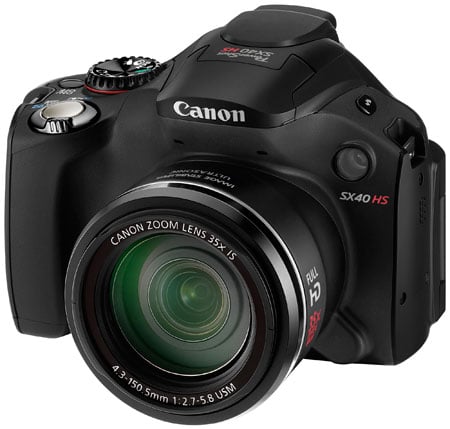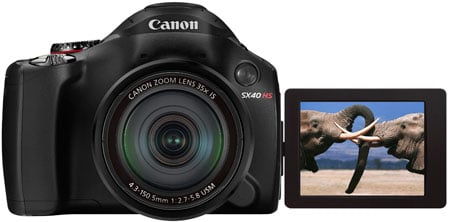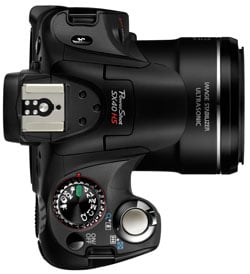Canon PowerShot SX40 HS
-
-
Written by Gordon Laing
Verdict
Canon’s PowerShot SX40 HS is a feature-packed camera with one of the longest zoom ranges on the market. The enormous 35x range starts at an equivalent of 24mm and doesn’t stop until you reach 840mm; that’s all optical too without any digital scaling. This range delivers a fantastic degree of flexibility, allowing you to capture huge landscapes, large buildings, big group shots or cramped interiors at one moment before zooming-in seconds later to grab a distant subject in great detail.
Sure Nikon and Olympus now have models boasting 36x zooms, but the difference between them and the 35x zoom of the SX40 HS is negligible. As such it’s fair to say they all share the broadest and longest ranges around. You can’t help but be impressed when you zoom from one end of the range to the other.
There is however one other camera which shares this powerful range: Canon’s earlier PowerShot SX30 IS. The new model inherits the same 35x lens, the same body, the same 2.7in articulated screen, the same hotshoe for external flashguns and the same controls. Like many new cameras, the difference between the SX40 HS and its predecessor is entirely internal and concentrated around a new sensor. This small change does however have a big impact on the overall quality and features of the SX40 HS.
 | |
Like Panasonic’s FZ150, Canon has taken its previous super-zoom and swapped its 14 Megapixel CCD sensor for a 12 Megapixel CMOS sensor. This allows the SX40 HS to enjoy Full HD 1080p video and much faster continuous shooting, while Canon claims lower noise levels over its predecessor. Let’s look at each in turn, starting with the still image quality.
Comparing the SX40 HS against its predecessor is all good news in terms of photos. The drop in resolution by 2 Megapixels hasn’t had a perceptible effect on real-life resolution, but this coupled with a different sensor technology and new image processor has definitely lowered noise levels. The earlier SX30 IS became quite smeared from 400 ISO upwards, and even at 200 ISO there were plenty of undesirable artefacts. In contrast the SX40 HS looks good up to 400 ISO, and delivers pretty usable results at 800 ISO. 1600 and 3200 ISO are a push too far unless you’re reproducing at very small sizes, but the addition of the composite Handheld Night Scene mode allows the camera to effectively reduce noise without smearing detail at high sensitivities. The often obvious coloured fringing on the earlier SX30 IS also appears reduced here.
Compared to the current competition, I’d say the SX40 HS enjoys a very minor edge over the Panasonic FZ150 and Sony HX100V on noise levels, although it’s a close thing and they’re all fairly equally matched in real-life resolution. That’s as far as in-camera JPEGs are concerned. The FZ150 does however enjoy one big advantage over the SX40 HS and most rivals though by also being able to shoot in RAW, which in my tests allowed significant highlight retrieval which was forever lost on JPEGs. For a full report see my Canon SX40 HS quality, Canon SX40 HS noise and Canon SX40 HS Handheld Night Scene results pages.
 | |
Moving-on, the second major upgrade thanks to the new sensor is the ability to record 1080p video compared to 720p on the older SX30 IS. This was a necessary move in the current market as all its rivals also offer 1080p video, but Canon has interestingly stuck with progressive video at 24fps. Native support for 24p will delight some independent film makers, but it’s important to note the Panasonic FZ150 and Sony HX100V both offer higher progressive frame rates of 50p or 60p depending on their region. These higher frame rates give you the chance to slow down footage in 25p or 24p projects while maintaining smooth playback.
Speaking of slow motion though, the SX40 HS enjoys an advantage over its rivals: the ability to shoot at either 240fps in QVGA resolution or 120fps in VGA resolution (to be played back at eight or four times slower than normal respectively), whereas the Panasonic FZ150 only offers a 220fps QVGA option, and the Sony HX100V has no high speed video at all.
The SX40 HS also lets you record videos with a miniature effect applied, offers a fun Movie Digest option which assembles short clips taken before still photos for a review of the day, and even allows you to adjust the audio recording levels, but it’s not all good news. In my tests I found the rolling shutter effect was more obvious and continuous autofocusing felt slower and less confident than the Sony HX100V and especially the Panasonic FZ150. Revealingly in my tests the AF performance was inversely proportional to the total zoom range, so while the FZ150 ‘only’ has a 24x optical zoom, it feels much snappier in use. The FZ150 also boasted a number of benefits to its movie mode which will swing it for video enthusiasts – I’ll describe them in more detail below.
The third upgrade on the SX40 HS thanks to its CMOS sensor is much faster continuous shooting than its predecessor. The earlier SX30 IS could only shoot at 1.3fps, whereas the SX40 HS can shoot at up to 10.3fps. Like its rivals, there are of course some caveats though: the 10.3fps mode is only available for a maximum burst of eight frames, corresponding to about one second’s worth of action. To be fair, the situation is essentially the same for the HX100V and FZ150, which can also only shoot for about one second at their top speeds. Like those models though, the SX40 HS also offers a slower speed, in this case 2.4fps, and you can keep shooting until you run out of memory. The 2.4fps and especially the 10.3fps options are a big improvement over the SX30 IS, although again the SX40 HS is out-featured by the Panasonic FZ150 which offers a useful intermediate option at 5.5fps or faster options at reduced resolutions.
I’m talking a lot about the competition now, so before my final verdict, let’s see how the SX40 HS compares against its closest rivals.
Compared to Sony Cyber-shot DSC-HX100V
The Sony Cyber-shot HX100V is the first major rival for the Canon SX40 HS, and is packed with features.
The biggest difference concerns the zoom range: 30x (27-810mm) on the HX100V versus 35x (24-840mm) on the Canon, so this time the Sony roughly matches the reach at the telephoto end, but doesn’t quite zoom as wide.
In terms of the screen, Sony has equipped the HX100V with a larger and much more detailed panel (3in / 920k vs 2.7in / 230k), although it only tilts vertically as oppose to the SX40 HS which twists and flips in any direction. Both cameras can shoot 1080p video, but like the FZ150 below, the HX100V does so at 50p or 60p depending on region compared to 24p on the SX40 HS; again though, some may prefer the native 24p output from the Canon. Sticking with video, the SX40 HS offers the choice of two slow motion options (320×240 at 240fps or 640×480 at 120fps) and can apply a miniature effect to 720p HD video, along with offering a fun Movie Digest feature.
Moving onto continuous shooting, both are fairly well-matched: ten frames at 10fps on the Sony compared to eight at 10.3fps on the Canon. Either way, you’re still only looking at capturing approximately one second’s worth of action.
Both cameras of course have popup flashes, but the Canon sports a hotshoe to mount external flashguns whereas the Sony does not. Both cameras also offer composite shooting modes which stack frame to reduce noise, but Sony takes the lead with multiple options including its innovative sweep panorama function (now higher resolution than ever before) and 3D image generation. The HX100V additionally sports a built-in GPS, something that’s unusually absent on the other super-zooms here.
The final big difference concerns their respective sensors: like Panasonic, Canon has reigned-in its Megapixels in an attempt to reduce noise, with the SX40 HS offering 12 Megapixels. This trend clearly hasn’t got through to Sony though which continues to push boundaries, equipping the HX100V with 16 Megapixels. As you’d expect, the Sony can capture slightly more detail at the lowest ISOs, but the Canon has the edge in noise at higher ISOs. That said as you can see in my results pages, the differences in both respects are pretty minor, especially if you’re printing images at the same size.
It’s another tough comparison to weigh-up, with the Canon boasting a slightly broader lens range, fully articulated screen, slow motion video and flash hotshoe against the Sony’s bigger, more detailed screen, Sweep and 3D Panoramas, and built-in GPS.
See our Sony HX100V review for more details.
Compared to Panasonic Lumix FZ150
The other major rival for the SX40 HS is Panasonic’s premium super-zoom, the Lumix FZ150, and once again both models share quite a lot in common. Both employ 12 Megapixel CMOS sensors with 1080p video capabilities and fast continuous shooting, along with articulated screens and flash hotshoes. Once again though it’s important to look more closely.
In terms of video, both cameras can shoot 1080p, although Panasonic has opted for 50p or 60p depending on region, while Canon has gone for 24p. Film makers always appreciate native 24p options, but the FZ150 has the advantage of shooting at faster frame rates, allowing slow motion playback in 24 or 25p projects. Sticking with slow motion, both cameras offer proper slow motion video modes at lower resolutions with 220 / 240fps at QVGA, but the Canon also adds a higher resolution VGA option, albeit at 120fps. That and the Movie Digest are nice extras for the SX40 HS, but overall the FZ150 is a more sophisticated camera for video. It boasts a microphone input for much improved sound quality (albeit lacking the manual levels option of the Canon), its miniature mode can be applied to 1080p video (the Canon can’t go above 720p with this effect), it can keep recording long clips until you run out of memory (apart from European models which stop at 29:59), and in use, the continuous autofocus felt much more confident and responsive.
Both cameras feature fully articulated screens, but the FZ150 wins the panel specification with 3in / 460k vs 2.7in / 230k; Canon’s really falling behind in this respect. Both cameras also feature quick continuous shooting, and while the top specs of 12fps for 12 frames on the FZ150 and eight frames at 10.3fps on the SX40 HS means both cameras will only be shooting for about one second, the FZ150 offers many additional speeds, including a useful 5.5fps mode with AF and much faster speeds at reduced resolutions.
The biggest advantage of the Canon SX40 HS over the FZ150 is its enormous 35x optical zoom range, which may be the same as the SX30 IS before it, but remains very impressive. It delivers an equivalent range of 24-840mm, essentially matching the FZ150 at the wide-end, but significantly out-reaching it in the telephoto stakes by over a third. This alone will swing the decision for those who want to get really close to distant action.
But in its favour, the FZ150 boasts RAW recording which really can retrieve blown highlights, manual control over movie exposures, longer clips, a microphone input which doubles-up as a remote control / intervalometer socket, a broader and more useful selection of continuous shooting options, and a bigger, more detailed screen. The FZ150 also felt more responsive in use, particularly in terms of autofocus.
In terms of image quality, there’s essentially nothing between their in-camera JPEGs, although again the FZ150 has the edge with support for RAW if you’re happy to process these later. So if you’re only shooting JPEGs and simply want the longest zoom range, then the SX40 HS should be your choice, but if you’re happy to trade the epic zoom for one that’s merely very impressive, the FZ150 offers much more for enthusiasts. It may ‘only’ have a 24x optical zoom, but it out-features and out-performs the competition in many respects.
For more information, see my Panasonic FZ150 review.
Also consider
Nikon COOLPIX P500
and
Olympus SP-810UZ
.
Canon PowerShot SX40 HS final verdict
The Canon PowerShot SX40 HS may be little more than the SX30 IS equipped with a new sensor, but this single change has a significant impact on the camera as a whole. The 720p video and paltry 1.3fps continuous shooting of the SX30 IS have now been upgraded to 1080p and up to 10.3fps (for eight frames anyway), while the switch to CMOS, drop in resolution and new image processor really do lower noise levels with no perceptible loss in real-life resolving power.
Considering you get all of this in a body which already housed one of the longest zooms on the market, and the SX40 HS is looking like a very strong camera. But it’s not all good news. Canon may have upgraded the sensor, but the screen remains the same as the previous generation, which was looking dated even back then. It may be fully articulated, but a 2.7in panel with 230k pixels is nothing to get excited about when almost everyone else is packing bigger and more detailed screens.
 | |
Then there’s the continuous autofocus while filming video, which often failed to lock-on or track for several seconds at a time, especially at longer focal lengths. Revealingly this is an area where its rivals with shorter zooms performed better. Certainly when you first start filming with the SX40 HS, Sony HX100V and Panasonic FZ150 alongside each other, you initially marvel at the longer zoom of the Canon, but before long you prefer using the others, especially the FZ150, for their more confident autofocusing when recording.
This extends to other aspects too. The SX40 HS has its fair share of features, but the Panasonic FZ150 boasts even more, such as support for RAW, higher video frame rates, longer recording times, an external microphone input, broader continuous shooting options and a bigger more detailed screen. And while the Sony HX100V lacks any kind of super slow motion video capture, it does have things like the amazing Sweep Panorama, 3D photo capture and a built-in GPS. See above for more detailed comparisons.
Canon may have improved the output and shooting speed of the SX40 HS by swapping its sensor, but the JPEG quality is essentially the same as its two rivals here, while falling behind on the gadgetry of the Sony and the high-end features of the Panasonic. Interestingly though if you only looked at the headline specifications, you may not notice. With a 35x zoom, 1080p video and 10.3fps shooting, the SX40 HS sounds like an unbeatable camera, but look closely at, and crucially test, the other aspects and the limitations become clear.
This in fact makes it easy to recommend each of the super-zooms to three different types of people. The Panasonic FZ150 is clearly the best choice for enthusiasts and higher-end videographers. Its quick handling, RAW support and external mic input will delight those who’ll exploit these features, and they’re unlikely to notice the zoom range is ‘only’ 24x. Meanwhile Sony’s HX100V will appeal to those who want a bigger zoom range and the company’s famous gadgetry like the Sweep Panorama and GPS.
As for the Canon SX40 HS, it will of course be chosen by those who love the idea of having one of the biggest zoom ranges on the market with a good balance of other features. This really should make it the best choice overall, but I can’t help returning to my experiences of each in the field. In particular the more I used the Panasonic FZ150, the more I appreciated its confident AF, support for microphones and ability to retrieve blown highlight detail from RAW files. In my view this makes it the best overall super-zoom and marks the SX40 HS down from our top award.
But once again if the FZ150’s benefits mean little to you it becomes a race between the Canon and the Sony, and there’s no denying the seductive reach of the former. As such the Canon PowerShot SX40 HS comes easily Recommended, but think very carefully about what you really want from a camera as one of the other models may be more appropriate.
Bad points | Scores (relative to 2011 super-zooms) |
 | ||
Build quality: Image quality: Handling: Specification: Value:
Overall: |
17 / 20 18 / 20 17 / 20 17 / 20 16 / 20
85% | |||






